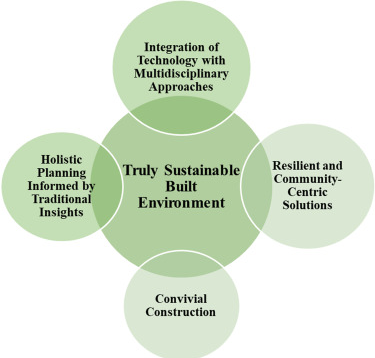Revitalizing the Built Environment: How Distributed Design Fosters Sustainability and Resilience
The built environment accounts for 40% of global resource consumption annually. Yet, it holds immense potential to transition from being a climate burden to a catalyst for sustainability and resilience. Achieving this shift requires a fresh perspective—one that blends cutting-edge technology with time-tested traditional knowledge, fostering innovative solutions deeply rooted in local contexts.
Distributed design is emerging as a transformative framework to drive this change. By decentralizing decision-making, it aligns global strategies with local needs through four guiding principles: holistic planning, multidisciplinary technology integration, community-centric solutions, and convivial construction. Together, these principles offer a roadmap for creating sustainable, resilient spaces.
1. Holistic Planning: Bridging Past and Future
Traditional knowledge, often sidelined in modern urban planning, offers invaluable insights into sustainable design. Architectural practices refined over centuries are deeply attuned to local climates, materials, and community needs. Distributed design draws on this wisdom, combining it with contemporary innovation to create built environments that resonate with their natural and cultural surroundings.
For example, Mediterranean structures historically employed natural cooling systems like semi-underground dwellings and thick stone walls to regulate temperature. Adapting these principles to modern construction can reduce energy consumption by up to 60%. Holistic planning weaves such strategies into urban design, balancing the technological efficiency of smart cities with the contextual sensitivity of vernacular architecture.
2. Multidisciplinary Technology Integration
Technology is at the heart of distributed design, but its impact is magnified when informed by a multidisciplinary approach. Tools like Building Information Modeling (BIM), laser scanning, and bioclimatic design enhance material use and energy efficiency. Their true potential, however, lies in their integration with cultural and environmental knowledge.
Consider using drones to document traditional masonry techniques or applying data analytics to evaluate the performance of local materials like cob or volcanic soil in different climates. Such insights give rise to “smart vernacular” solutions that marry traditional materials with modern engineering, producing energy-efficient structures that honor local identity while addressing global sustainability goals.

3. Resilient, Community-Centric Solutions
Resilience in distributed design extends beyond physical structures to include social cohesion. Actively involving communities in the design and construction process fosters a sense of ownership and pride, while preserving and passing down traditional knowledge.
Participatory workshops and apprenticeships exemplify this approach, enabling local craftspeople and residents to collaborate on restoring or building structures using traditional methods. Blending these techniques with modern sustainability features—such as water management systems or renewable energy solutions—enhances both environmental and social resilience.
4. Convivial Construction: Empowering Local Solutions
Conviviality emphasizes collaboration and autonomy, promoting accessible, low-tech methods that communities can adopt and adapt. Natural building techniques like cob and rammed earth are cost-effective, sustainable, and culturally expressive, enabling communities to shape environments that reflect their unique values.
For instance, using volcanic materials in Greece or cob in colder regions showcases how localized approaches can inspire global innovations. By empowering individuals to experiment and innovate, convivial construction fosters creativity and self-sufficiency while advancing sustainable practices worldwide.
The Way Forward
Distributed design transforms the built environment into a driver of sustainability by integrating holistic planning, technology, community engagement, and convivial methods. Its strength lies in its adaptability: while its principles are universal, its applications are deeply local, ensuring every project reflects the cultural and environmental context it serves.
This fusion of tradition and innovation empowers communities to create spaces that embody their needs and aspirations. More than a framework, distributed design is a movement—one rooted in heritage, guided by technology, and driven by people. It offers a vision for a future where the built environment is sustainable and regenerative.
This article is inspired by “Can Smart Technology and Traditional Wisdom Craft Truly Sustainable Built Environments?” by Christina Priavolou, published in Building and Environment, 2025.
Cover photo credits: Borys Zaitsev
